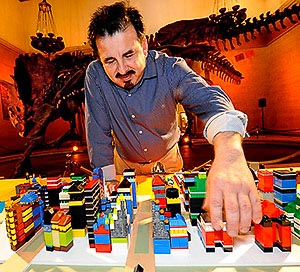The artist and urban planner has developed a new way of working with communities by encouraging them to use toys and other objects to help make models of what, exactly, they want their communities to look like.
By ditching traditional planning tools like elevation plans, artist’s renderings and maps in favor of toys and other gizmos, Rojas hopes to make urban planning a less intimidating process that’s more accessible to communities.
“Having this in a playful venue, you create a safe space where people can explore infinite possibilities,” says Rojas, who's worked with municipalities, community groups and other non-profits to bring his process to cities nationwide. “There’s no right or wrong answers. You just create it.”
The technique is essentially a way for urban planners to ask residents open-ended questions about what they value in a city and how they want to see their community improve. It also helps ensure residents have a stake in urban planning.
“Our hardest job as planners is how do we get people engaged in the planning process?” Rojas says. “How do we get them to tell their stories about who they are and what they value?”
The methods he uses allow people to easily share their answers to those questions.
Rojas will lead a design workshop Tuesday night at the Leonel J. Castillo Community Center. On Monday, he gave Houston architects, urban planners and others a closer look at the workshop process he’s performed 400 times at workshops across the country.
He opened the meeting at Rice University by asking everyone in the room to answer a simple question: “what’s your favorite childhood memory?” Inevitably, the answers involved things like riding bicycles and going to baseball games.
The question served two purposes, Rojas says. For starters, it gets people comfortable opening up to strangers. But it also helps participants convey their values, including things like a love of outdoors and recreation.
Then, residents were asked to perform a simple task. Using cheap found objects placed on tables across the room – things like plastic Easter eggs, pipe cleaners and toy Army men – they were told to design their ideal version of Houston.
The idea is to have a free-wheeling discussion, in which participants can come up with limitless ideas and not feel constrained by the status quo. “I want you think about your ideas and your fantasies,” Rojas says. “A lot of times, people see maps of the cities and say ‘I can’t do that.’”
“By having you do it this way, it’s not complicated,” Rojas continues. “People can be free-thinkers.”
He says he was inspired to develop the unusual technique through his previous work with artists, who he says have a knack for relating to the public. As the founder of a Los Angeles art gallery and a former transportation planner for the Los Angeles County Metropolitan Transportation Authority, his current role combines his experience from both fields.
At his Rice workshop, teams worked on the projects and then explained them to the whole group – and they almost always needed an explanation. A popsicle stick might represent a light-rail line, or a pipe cleaner a major highway. While none of the plans were sophisticated enough to function like blueprints, they did get a broad cross-section of residents speaking about what, exactly, they want to see in their city. Because the process is hands-on, Rojas says, it’s often easier for participants to visualize and ultimately explain what they want to see in their community than it is at a usual public hearing.
Themes like the need for park space and transit emerged over and over again.
“A city is visual, spatial and experiential,” Rojas says. “The problem is most planning meetings are about words. They’ll argue to death, and you can’t compromise. But when you play with a space, you can see compromises.”
Rojas documents his meetings by taking photos and videos of participants’ designs and making notes of their explanations. His clients have included the cities of Los Angeles, Boulder, Raleigh and Santa Monica, among others.
“For us, it’s important to have all the input, no matter what it is,” Rojas continues. “You want to give people all that flexibility, to define who they are what they are.”
By playing with toys, Rojas says, participants can collaborate with strangers in a way that might otherwise make them uncomfortable. “You’re pulling away differences,” Rojas says. “There’s a sense of belonging and of intimacy. We have less of it as adults than we did as children.”
His techniques emphasize the idea that everybody can contribute to the planning process. He’s put a particular focus on increasing awareness of planning issues facing low-income Latinos.
“The whole idea is it’s about civil rights,” Rojas says. “You can be a refugee who’s only been in the U.S. for a day, but your memory is of value to us.”
A typical meeting lasts about an hour and can include people young and old. Usually they’re performed in smaller community settings, rather than city-wide, which makes them especially attractive to immigrant communities, Rojas says.
“Everybody already knows more about the city than the planner does,” Rojas says. “Rather than me telling you what you want, you tell me. This is how we need to think about planning.”

